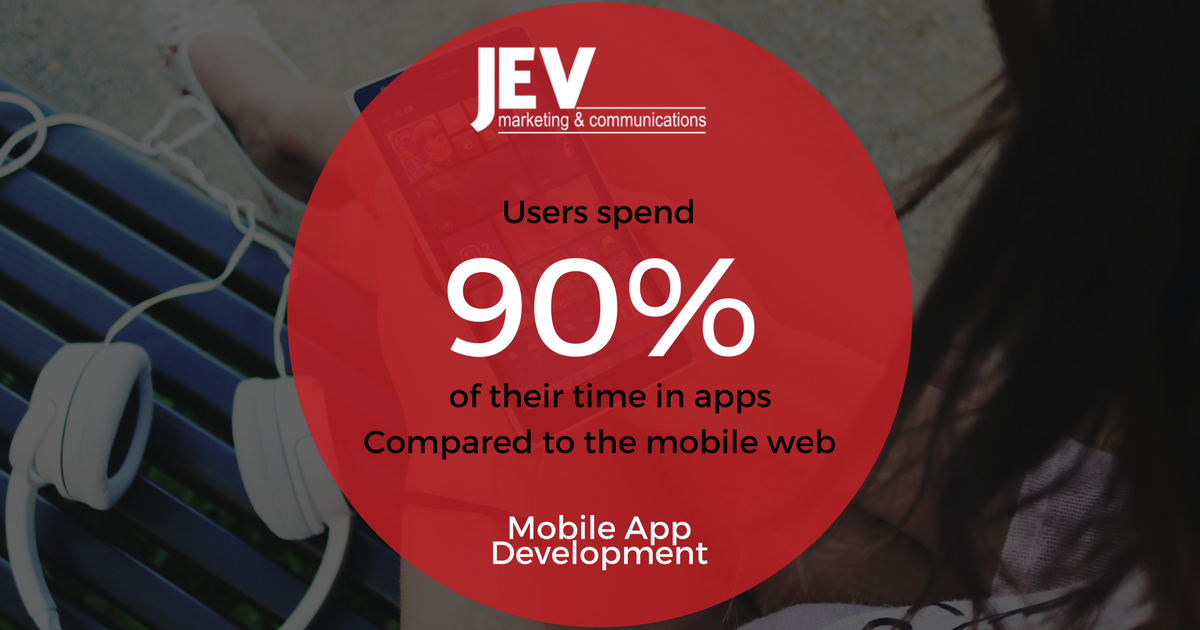How To Choose A Mobile App Best Suited For Your Company
Monday, April 24, 2017

Why a Mobile App?
As Matt Galligan, former CEO of Circa News, put it “The future of mobile is the future of everything”. Currently, users spend 90% of their time in apps as compared to a mobile website, as shown by Smart Insights. This means that this constantly growing connection with their mobile devices can only increase the opportunities your business has to reach them.
Mobile apps can include easily updated content. There are also multiple branding opportunities with the visual real estate you now have on their devices. Lastly, it will allow for features such as push notifications.
How to Choose A Mobile App
What Types of Mobile Apps Are Out There
There are three types of mobile apps, Native Apps, Hybrid Apps, and Mobile Websites. Let’s go over each type and talk about the advantages and disadvantage of each.
Native Apps
Native apps are what people think of when they initially think of mobile apps. They are accessed through an icon on the device, and often do not need an internet connection to work.
Native apps can be a bit of a hassle. They have to be created individually for each operating system. They may also have to complete in different sizes for a different device. For example, like a smartphone vs. a tablet. This means if you want your app to be in the Apple Store and the Google Play Store. Two separate versions of the app will have to be created. It also means any updates that have to be completed will have to be done on each separate platform as well. This is also why this type of app is typically the most expensive to develop and maintain.
However, if done right you can have amazing results; native apps do have the highest performance out of the three options, leading to the best user experience. They allow for close integration into the operating system of the device. This means they can access features like the camera, geolocation, gyroscope, and the accelerometer.
Hybrid Apps
The next type of app is a hybrid app. This, as its name suggests, is a hybrid between a mobile website and a native app. These apps are accessed through an icon on the device. But may require an internet connection for any links to web pages. In a sense, it is a mobile website in a native app’s clothing. They are often existing web pages put into an app. For a company to get a presence in the app store and amongst users mobile devices.
Hybrid apps can be a bit slower than a native app. This is because it is pulling cached information from the device as well as from the online server. This can take away from the overall user experience of the app. While it can use many functions on the device, similar to the native apps, there are some limitations to its ability to integrate with the operating system.
Hybrid apps do not require the apps to be created completely separately for each operating system. Many of the components during the development processed can be shared amongst different operating systems. Although certain components do have to created separately. This will put the cost somewhere in between native and mobile websites.
Mobile Website
On the other end of the spectrum, mobile websites are very different from native apps. Mobile websites are essentially responsive web pages that open in a device’s browser. This would mean that these apps require internet connection.
Mobile websites will allow for little integration into the operating system. With access to features like geolocation, and sometimes the camera. Mobile websites will also not allow for any app store presence. This is because there is no physical app to download onto a device.
Web websites tend to cost the least, which can work on all operating systems with very few to no differences. This can make it easier to update later on as one change will update the site on all platforms.
What Type is Best for My Business
As with most business practices, what is best for your business may be different from someone else’s. It is important to evaluate your company’s goals and objectives for your app. Then decide on a price point for the development of the app. Additionally, and likely the most important factor, is how you want to interact with your customers. An app is all about the experience the user has.
What’s Next?
We would be happy to help bring your idea to life and ensure your app produces and ROI. Here is our process for creating mobile apps:
Research and Discovery
In this initial phase, we will work on defining your goals and hold brainstorming and discovery sessions. During this stage, we may also conduct user research in the form of surveys and interviews.
Strategy and Experience
Taking what we learned from the previous stage we will begin to develop user personas. Empathy maps and experience maps to better identify with the users. As a part of user experience design and strategy, we will also put together the user flow. Information architecture, sitemaps, and compiling user stories.
User-Centred Design
This will involve initial concept sketching, designing wireframes, building clickable prototypes, and ultimately visual design.
Application Development
In this stage, we will take the information gathered in the previous stages. Begin the actual development of the application, now that we have a complete design and specification document.
Conclusions
Deciding what type of app to create for your company can make or break how your users see your brand. We would be happy to help you out with that process. You can contact us or request a quote for app development on our quote request form.
Next, let’s break down that information a bit:
| Type | Advantages | Disadvantages |
| Native Apps |
|
|
| Hybrid Apps |
|
|
| Mobile Website |
|
|
